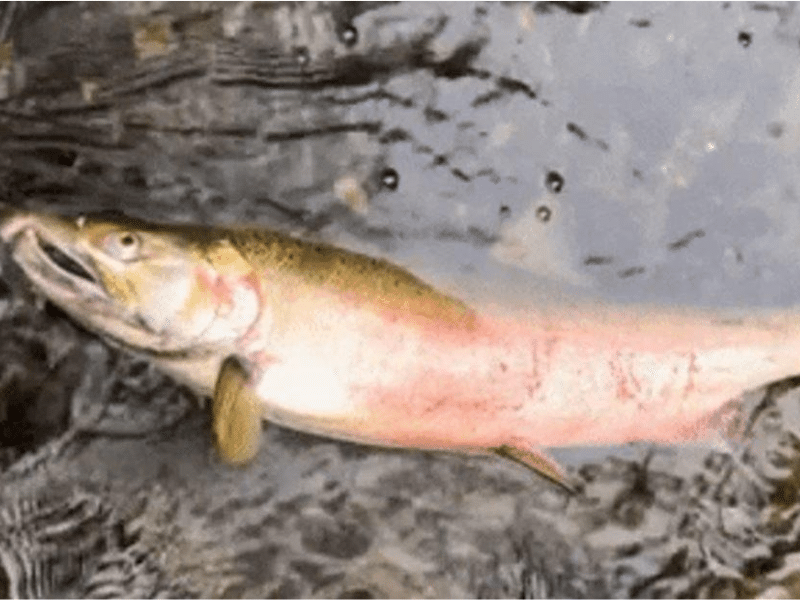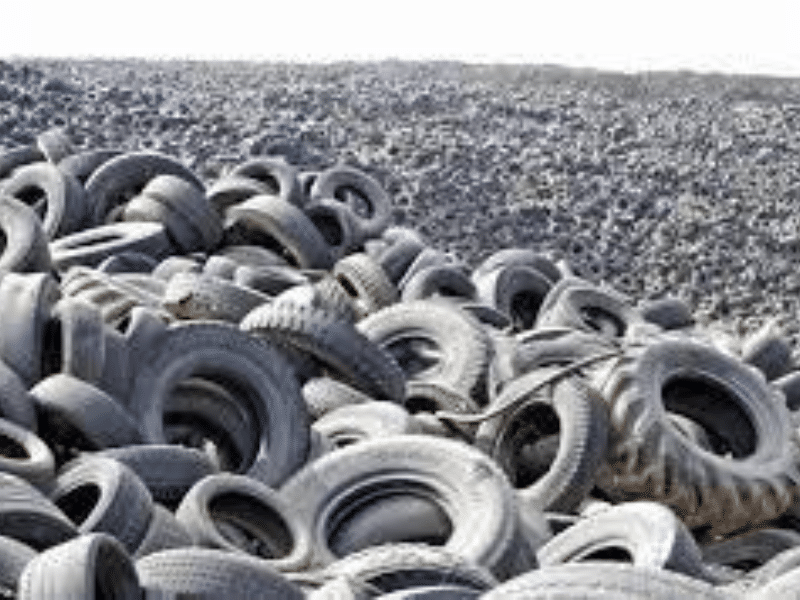As environmental concerns – and the resulting regulatory landscape – evolve, all construction industry stakeholders are conscious of the potential impact of these shifts on their businesses. In this post, we provide an update on the latest research into 66PD-Quinone, a compound widely used in rubber tires and the possible regulatory impact of those findings.
For decades, a condition known as urban runoff mortality syndrome (URMS) has caused Coho salmon to die prematurely. While the association between URMS and urban development has been well documented since the 1980s, the exact toxicant linked to URMS has been a mystery. In a seminal study in 2021, scientists from the University of Washington and Washington State University researching URMS discovered a new environmental contaminant with a strong causal link to URMS: 6PPD-quinone (Tian, et al., 2021).

In 2021, 6PPD-quinone was discovered to be the predominant cause of urban runoff mortality syndrome, a disease causing Coho salmon to die yearly prior to spawning. Image credit: Northwest Public Broadcasting.
Discovery and Occurrence of 6PPD-Quinone
To date, the most-studied source of 6PPD-quinone has been the oxidation of tire rubber. A compound called 6PPD is used in almost every one of the estimated 3.1 billion tires manufactured across the globe annually in the world. In tires, 6PPD migrates through the rubber to the surface of the tire, where it reacts preferentially with ozone and oxygen in the air near the ground surface during a process called, “blooming” (State of Washington Department of Ecology, 2021). This oxidation reaction sacrifices the 6PPD in the rubber formulation to prevent degradation, fatigue, and cracking of the rubber, an important feature for the safety of drivers and passengers (U.S. Tire Manufacturers Association, 2021). 6PPD makes up between 0.4% to 2% of the mass of a tire (Tian, et al., 2021).
One of the metrics that toxicologists use to describe the toxicity of a substance is LC50, which measures the concentration of a substance that causes death in 50% of a test population. In the 2021 paper, Tian et al determined an LC50 value for 6PPD-quinone in Coho salmon of 790 nanograms per Liter (ng/L); in 2022, the value was revised to 95 nanograms per Liter, meaning 6PPD-quinone is 8.3 times more toxic to Coho salmon than originally thought (Tian, et al., 2022). Other studies have revealed no mortality connection to 6PPD-quinone in Atlantic salmon and brown trout and LC50 values of 590 ng/L and 1000 ng/L in brook trout and rainbow trout, respectively (Caltest Analytical Laboratory, 2023).
Due to its recent discovery and the concentration of research regarding its association with URMS in Coho salmon, toxicity assessments of 6PPD-quinone have focused on aquatic species. However, as the breadth of the literature expands, 6PPD-quinone and at least five other quinones of other rubber anti-degradants have been identified in dust samples, air samples, and roadside soil samples (Cao, et al., 2022).
The Emerging Regulatory Landscape
Between February and April 2023, The United States Environmental Protection Agency (EPA) accepted public comments and nominations for the Sixth Contaminant Candidate List. The Contaminant Candidate List is a list of potential drinking water contaminants that may require regulation under the Safe Drinking Water Act (United States Environmental Protection Agency, 2023). While the Contaminant Candidate List does not necessarily prescribe any regulations on contaminants, it is a viable first step in the national regulation of 6PPD and 6PPD-quinone in drinking water. It is important to remember that 6PPD-quinone was only discovered in 2021 and it may take years before federal regulations with the force of law are promulgated.
It appears however, that action is moving more quickly at the state level with California and Washington among those acting first. Following the discovery of 6PPD-quinone, the Washington State Legislature approved an almost $200,000 budget for the Department of Ecology to assess the hazards of 6PPD and its breakdown products as well as perform a hazard assessment on selected alternatives (State of Washington Department of Ecology, 2021). On May 23, 2022 the State of California Department of Toxic Substances Control proposed a rule requiring tire manufacturers to research safer alternatives to 6PPD (California Department of Toxic Substances Control, 2022).
A Narrow Focus Leaves Room for Many More Questions
Due to the preponderance of research on 6PPD-quinone that has been focused on fish species, tire rubber, and urban stormwater runoff, many questions still remain on this topic. Active fields of investigation regarding 6PPD-quinone include toxicity in non-aquatic animals and humans, as well as non-tire sources of rubber anti-degradant transformation products.
Tire rubber is routinely recycled to produce a multitude of products including artificial turf, roof shingles, synthetic mulch, asphalt, playground flooring, and aggregates. It is simply not yet understood how 6PPD in recycled rubber products reacts to form 6PPD-quinone. It is also easy to imagine that landfills, waste tire collection sites, automotive repair centers, and any other businesses associated with tires and waste tires may eventually be responsible for 6PPD-quinone in stormwater runoff. Beyond tires, much is still unknown about the potential of the universe of other rubber products like shoes, erasers, cell phone cases, and mattresses may contribute pollutants to the natural environment.

Tire Dumps, like the one in Kuwait photographed above, may come to be understood to be a major source areas of 6PPD-quinone pollution. Image credit: ExclusivePix.
VERTEX will continue to monitor the scientific and regulatory developments surrounding 6PPD-quinone. VERTEX’s urgent and flexible approach assists clients who will inevitably be called upon to respond to insurance claims and remediation projects associated with 6ppd-quinone in the coming years.
For more information on research and regulatory development into 6PPD, 6PPD-quinone, and environmental issues with impacts on the industry, please contact calebsmith@vertexeng.com.
References
California Department of Toxic Substances Control. (2022, May 23). California Proposes Requiring Tiremakers to Consider Safer Alternative to Chemical that Kills Coho Salmon. Retrieved from DTSC: https://dtsc.ca.gov/2022/05/23/news-release_t-07-22/
Caltest Analytical Laboratory. (2023). 6PPD Quinone and Its Impact on the Environment. Retrieved from Caltest Analytical Laboratory: www.CaltestLabs.com
Cao, G., Wang, W., Zhang, J., Wu, P., Zhao, X., Yang, Z., . . . Cai, Z. (2022). New Evidence of Rubber-Derived Quinones in Water, Air, and Soil. Environmental Science & Technology, 4142-4150.
Kryuchkov, F., Foldvik, A., Sandodden, R., & Uhlig, S. (2023). Presense of 6PPD-quinone in runoff water samples from Norway using a new LC-MS/MS method. Frontiers in Environmental Chemistry.
State of Washington Department of Ecology. (2021). Technical Memo: Assessment of potential hazards of 6PPD and alternatives. State of Washington.
Tian, Z., Gonzalez, M., Rideout, C., Zhao, H., Hu, X., Wetzel, J., . . . Kolodziej, E. (2022). 6PPD-Quinone: Revised Toxicity Assessment and Quantification with a Commercial Standard. Environmental Science & Technology Letters, A-G.
Tian, Z., Haoqi, Z., Peter, K., Gonzalez, M., Wetzel, J., Wu, C., . . . Kolodziej, E. (2021). A uqbiquitous tire rubber-derived chemical induces acute mortality in coho salmon. Science, 185-189.
U.S. Tire Manufacturers Association. (2021). RE: Department of Ecology research on 6PPD and proposed alternatives to 6PPD. U.S. Tire Manufacturers Association.
United States Environmental Protection Agency. (2023, September 22). Contaminant Candidate List (CCL) and Regulatory Determination. Retrieved from EPA: https://www.epa.gov/ccl/draft-contaminant-candidate-list-6-ccl-6




